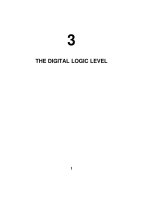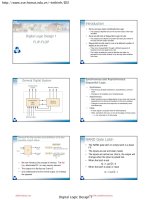Lecture Digital logic design - Lecture 20: Sequential circuits: Latches
Bạn đang xem bản rút gọn của tài liệu. Xem và tải ngay bản đầy đủ của tài liệu tại đây (678.48 KB, 37 trang )
��������������������������������������������������������������������������������������������������������������������������������������������������������������������������������������������������������������������������������������������������������������������������������������������������������������������������������������������������������������������������������������������������������������������������������������������������������������������������������������������������������������������������������������������������������������������������������������������������������������������������������������������������������������������������������������������������������������������������������������������������������������������������������������������������������������������������������������������������������������������������������������������������������������������������������������������������������������������������������������������������������������������������������������������������������������������������������������������������������������������������������������������������������������������������������������������������������������������������������������������������������������������������������������������������������������������������������������������������������������������������������������������������������������������������������������������������������������������������������������������������������������������������������������������������������������������������������������������������������������������������������������������������������������������������������������������������������������������������������������������������������������������������������������������������������������������������������������������������������������������������������������������������������������������������������������������������������������������������������������������������������������������������������������������������������������������������������������������������������������������������������������������������������������������������������������������������������������������������������������������������������������������������������������������������������������������������������������������������������������������������������������������������������������������������������������������������������������������������������������������������������������������������������������������������������������������������������������������������������������������������������������������������������������������������������������������������������������������������������������������������������������������������������������������������������������������������������������������������������������������������������������������������������������������������������������������������������������������������������������������������������������������������������������������������������������������������������������������������������������������������������������������������������������������������������������������������������������������������������������������������������������������������������������������������������������������������������������������������������������������������������������������������������������������������������������������������������������������������������������������������������������������������������������������������������������������������������������������������������������������������������������������������������������������������������������������������������������������������������������������������������������������������������������������������������������������������������������������������������������������������������������������������������������������������������������������������������������������������������������������������������������������������������������������������������������������������������������������������������������������������������������������������������������������������������������������������������������������������������������������������������������������������������������������������������������������������������������������������������������������������������������������������������������������������������������������������������������������������������������������������������������������������������������������������������������������������������������������������������������������������������������������������������������������������������������������������������������������������������������������������������������������������������������������������������������������������������������������������������������������������������������������������������������������������������������������������������������������������������������������������������������������������������������������������������������������������������������������������������������������������������������������������������������������������������������������������������������������������������������������������������������������������������������������������������������������������������������������������������������������������������������������������������������������������������������������������������������������������������������������������������������������������������������������������������������������������������������������������������������������������������������������������������������������������������������������������������������������������������������������������������������������������������������������������������������������������������������������������������������������������������������������������������������������������������������������������������������������������������������������������������������������������������������������������������������������������������������������������������������������������������������������������������������������������������������������������������������������������������������������������������������������������������������������������������������������������������������������������������������������������������������������������������������������������������������������������������������������������������������������������������������������������������������������������������������������������������������������������������������������������������������������������������������������������������������������������������������������������������������������������������������������������������������������������������������������������������������������������������������������������������������������������������������������������������������������������������������������������������������������������������������������������������������������������������������������������������������������������������������������������������������������������������������������������������������������������������������������������������������������������������������������������������������������������������������������������������������������������������������������������������������������������������������������������������������������������������������������������������������������������������������������������������������������������������������������������������������������������������������������������������������������������������������������������������������������������������������������������������������������������������������������������������������������������������������������������������������������������������������������������������������������������������������������������������������������������������������������������������������������������������������������������������������������������������������������������������������������������������������������������������������������������������������������������������������������������������������������������������������������������������������������������������������������������������������������������������������������������������������������������������������������������������������������������������������������������������������������������������������������������������������������������������0
0
Avoid
1 (set)
20
Characteristic Table
° In order to remember previous inputs, sequential circuits
must have some sort of storage element. This storage
element is called “flip-flop”.
° Flip-flop depends on previous inputs to the circuit.
° The basic memory unit is called an SR flip-flop.
° We can describe flip-flops using characteristic table.
SR Flip-Flop operation (BUILT WITH NOR GATES)
Characteristic table
Excitation table
S
R
Action
0
0
0
1
1
Q(t)
Q(t+1)
S
R
Action
Keep state 0
0
0
X
No
change
1
Q=0
0
1
1
0
reset
0
Q=1
1
0
0
1
set
1
Unstable
combinati
on
1
1
X
0
race conditio
21
Review: Steering Gates
° The flow of logic can be controlled with a logic
gate.
1
Signal
10
°°10
1
Control
The NAND as a steering gate inverts the input.
22
Steering Gates
° A control input ‘0’ inhibits the signal.
01
1
Signal
°°10
1
Control 0
23
Steering Gates
Signal
01
1
Control
°°10
1
Signal
0
1
°°10
Output Enabled (inverted)
24
Steering Gates
Signal
10
Control
°°10
1
0
Signal
101
1
°°10
Output Disabled
25
An SR latch with a control input
° Here is an SR latch with a control input C
C
S
R
S’
R’
Q
0
1
1
1
1
x
0
0
1
1
x
0
1
0
1
1
1
1
0
0
1
1
0
1
0
No c h ang e
No c h ang e
0 ( r e s e t )
1 ( s e t )
A vo id !
° Notice the hierarchical design!
• The dotted blue box is the S’R’ latch from the previous slide
• The additional NAND gates are simply used to generate the correct
inputs for the S’R’ latch
° The control input acts just like an enable
26
S-R Latch with NANDs
S
R
Q
S R Q Q’
Q’
0
0
1
1
0
1
0
1
1
1
0
0
1
1
0
1
1
0
Disallowed
Set
Reset
Store
° Latch made from cross-coupled NANDs
° Sometimes called S’-R’ latch
° Usually S=1 and R=1
° S=0 and R=0 generates unpredictable results
27
S-R Latches
28
S-R Latch with control
input
° Occasionally, desirable to avoid latch changes
° C = 0 disables all latch state changes
° Control signal enables data change when C = 1
° Right side of circuit same as ordinary S-R latch.
29
NOR S-R Latch with Control Input
Latch
Latch is
is level-sensitive
level-sensitive,, in
in regards
regards to
to C
C
Only stores data if C’ = 0
R’
Q
C’
Latch
Latch operation
operation S’
enabled
enabled by
by
C
C
Input sampling
enabled by gates
Q’
Outputs
Outputs change
change
when
when C
C is
is low:
low:
RESET
RESET and
and SET
SET
Otherwise:
Otherwise: HOLD
HOLD
30
Problems with SR Latch
° The problem with the SR Latch is that it requires
two inputs to store one value.
° A latch is needed where one input is applied to
store one value.
° A control input is also required to place the device
in a hold state.
° Moreover there is a race condition (undefined)
31
D Latch
° Q0 indicates the previous state (the previously
stored value)
X
D
S
Q
C
Q’
R
Y
D C Q Q’
0 1 0 1
1 1 1 0
X 0 Q0 Q0’
X Y C Q Q’
0
0
1
1
X
0
1
0
1
X
1
1
1
1
0
Q0 Q0’ Store
0 1 Reset
1 0 Set
1 1 Disallowed
Q0 Q0’ Store
32
D Latch
X
D
S
Q
C
Q’
Y
R
D C Q Q’
0 1 0 1
1 1 1 0
X 0 Q0 Q0’
° Input value D is passed to output Q when C is high
° Input value D is ignored when C is low
33
D Latch
Latches on following
edge of clock
E
x
E
D
C
Q
z
x
z
° Z only changes when E is high
° If E is high, Z will follow X
34
D Latch
Latches on following
edge of clock
E
x
E
D
C
Q
z
x
z
° The D latch stores data indefinitely, regardless of
input D values, if C = 0
° Forms basic storage element in computers
35
Symbols for
Latches
° SR latch is based on NOR gates
° S’R’ latch based on NAND gates
° D latch can be based on either.
36
Summary
° Latches are based on combinational gates (e.g. NAND,
NOR)
° Latches store data even after data input has been
removed
° S-R latches operate like cross-coupled inverters with
control inputs (S = set, R = reset)
° With additional gates, an S-R latch can be converted to
a D latch (D stands for data)
° D latch is simple to understand conceptually
• When C = 1, data input D stored in latch and output as Q
• When C = 0, data input D ignored and previous latch value output at Q
37









